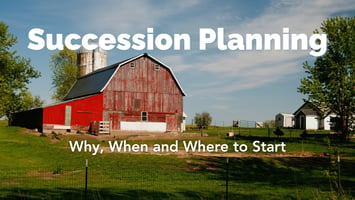Ag Issues: Soil Health
Farming is essential work, led across the country by people facing new challenges. From economic viability and labor shortages to technological advances and succession planning, today’s agricultural professionals are thinking about more than their grandparents were.
This new series dives into the top issues facing farmers in the next 10 years. Something on your mind? Fill out our contact form to let us know what you’d like to hear about.

Why should I care about how healthy my soil is?
Healthy soil regulates water and pollutants. The healthier the soil is, the more effectively it retains water. This supports plant growth and prevents runoff into natural waterways, keeping fertilizer and nutrients in the ground where they need to be. Clay minerals in healthy soil can also help filter, buffer and immobilize potential pollutants, disarming them from causing harm.
Healthy soil sustains life. Plants require healthy soil to grow strong, including crops, forage and wildflowers. High-quality forage lets livestock hit nutritional goals and grow faster. Stronger crop yields increase stocks and opportunities for farmers to market more products.
Healthy soil cycles nutrients. Many elements essential to crop growth, such as carbon, nitrogen and phosphorus are cycled within the soil, further increasing the fertility of the soil for future planting seasons.
Really, healthy soil means more profits for farmers.

So what exactly is soil health?
Soil health is the continued capacity of soil to support a living ecosystem. Without healthy soil, crop yields plummet, livestock don’t receive the required nutrients to grow, and land erodes until there is nothing usable left.
Healthy soil is determined by the chemical composition of soil, the biological diversity of organisms, and the physical characteristics it presents. It has good drainage, a dark color, and lots of earthworms.
Unhealthy soil is dry, compacted and lacking in life, both plants and microorganisms. Roots in unhealthy soil stay shallow as water cannot infiltrate the ground. The surface can also form a crust, which makes it difficult for seedlings to emerge and for future rains to soak in, compounding the issue of dry soil.
Drought can affect soil health, with the reduction in water availability altering nutrient cycling and reducing microbial activity. Flooding can also impact soil health by increasing nitrogen and potassium in soil via new sediment deposits or by erosion, diminishing already available nutrients.

(Image Source: Olga - Adobe Stock)
What’s the state of soil health today?
There is not one standard for soil health across the globe. Conditions vary across continents, countries, regions and fields. We do know that traditional agricultural practices have taken a toll on topsoil health, using up available nutrients and reducing the soil’s ability to filter water and regulate the carbon cycle.
In December 2014, at a UN Forum on World Soil Day, Maria-Helena Semedo of the Food and Agriculture Organization (FAO) claimed that the world’s top soil could be gone within the next 60 years, putting us today at 50 growing seasons left. However, those claims are contested by experts who believe techniques to improve soil health can extend these projections.
Over the last few years, U.S. crop production has maintained a steady pace. Still, with global populations rising and demands on crops for food and energy resources increasing, preserving soil health remains important for producers.

What can I do?
Soil experts have developed a variety of techniques to incorporate into everyday agriculture to improve soil health without stalling productivity. These regenerative farming practices reinforce the cyclical nature of our relationship with the land we work on and, once incorporated, can help farms thrive..png?width=290&height=290&name=Website%20feature%20images%20(1).png)
Maximize the presence of living roots. Living roots are the best source of food for microbes, which provide nutrients back to growing crops and soil.
Minimize disturbances. Mechanical tilling can disrupt natural and biological processes within soil that keep it productive. Reducing or stopping tilling can improve plant growth, reduce erosion, and provide a safer habitat for wildlife.
Maximize biodiversity. In addition to animals, increasing the biodiversity of planted crops can stimulate plant growth, as well as prevent pests and diseases from decimating a field. Biodiversity can be attained in a variety of ways, including crop rotations and planting cover crop mixes.
Increase soil cover. Maximize planting of cover, annual and perennial crops on fields and leave them each season to act as mulch under the next round of crops. This both protects soil from erosion and increases the nutrients in the ground as plants decompose.
Bonus tip: Utilize animals. Rotational grazing is a natural way to aerate and till soil without disruptive heavy machinery. It also prevents overgrazing and gives land time to recover. Animals’ manure also creates natural fertilizer, which can be spread among crops to boost their ability to absorb nutrients, air and water, as well as prevent land erosion.

Want to learn more?
The Soil Health Institute is a global nonprofit that researches soil health and promotes regenerative agriculture practices. The USDA also hosts videos and information about improving soil health on its website.
- - -
Hi! We’re Trader PhD, an Ag Marketing service located in West Des Moines, Iowa. We give commodity market advice to grain and livestock producers across the U.S. and Canada.
With over 30 years of experience serving farmers and ranchers, our team specializes in strategic hedging and speculating in the livestock and grain markets. We offer essential tools and market insights that help agricultural professionals make informed decisions, safeguard profitability, and manage commodity marketing efficiently.
Articles about current market trends are published on our app daily. Sign up for your free trial today for full access to Trader PhD’s editorial catalogue.
PAST PERFORMANCE IS NOT INDICATIVE OF FUTURE RESULTS. FUTURES TRADING INVOLVES SUBSTANTIAL RISK AND IS NOT SUITABLE FOR ALL INVESTORS.
.png?width=2347&height=620&name=outlined%20ag%20marketing%20logo%20black%20(1).png)




